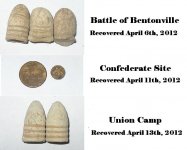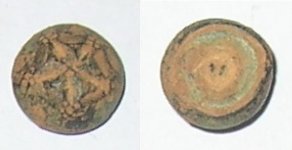gtoast99
Sr. Member
Hey everyone! Sorry for the long post. If you want to skip ahead to the pics, please feel free, HAHA
I haven't found anything amazing lately that would warrant it's own post, but I thought I'd post a few things I have found lately over several hunts. In the process, I'll make a short commentary about a subject few relic hunters want to discuss, but which is important for us all to be aware of. Namely, the temptation to identify an item the way you want it to be, even if the evidence is lacking to make that claim.
Last weekend I took a trip down to the Battle of Bentonville, NC with a few guys from the Raleigh detecting club. Kinda slow day for B-ville, but three bullets is better than nothing. You can read more about the hunt at the blog.
Wednesday I went to a Confederate site near home. I've found two good buttons out there in the past, VA and NC, along with a few other period finds. In the middle of that area I pulled this TINY brass two-piece cuff button with a flower design.
And here is where the temptation comes in. It's well known that the poorly equipped Confederates often used civilian flower buttons and gilted flat buttons on their uniforms. It is easy to find similar civilian buttons online listed as "Confederate." So did I find another Confederate button in that field near home? As tempting as it is to declare this a "Confederate button," I will stop short of making that claim. Although it MAY have been used by a Confederate, it was designed as a civilian button, and the field in which it was found has been farmed by civilians for some 200+ years. This is why responsible relic hunters stress the importance of good record keeping. The best I can do is record the provenance of the item for the future, and to ascribe any more significance to it would simply be disingenuous.
Yesterday I went off to do some more surveying to locate a Union camp my friend and I have been working on, and pulled out two pretty three ringers. I also found this cool pocket knife. Since it was found near the camp site, it clearly belonged to a soldier, right? No? Good, you passed the test. Pocket knives like this were made during the period, but their design has changed very little since then. I will have to do some more research to find out if this is a period knife, although it's likely that I will never really be sure.
Any help on ID'ing the age of the knife would be appreciated. Thanks for looking and in advance for any comments you might have!
I haven't found anything amazing lately that would warrant it's own post, but I thought I'd post a few things I have found lately over several hunts. In the process, I'll make a short commentary about a subject few relic hunters want to discuss, but which is important for us all to be aware of. Namely, the temptation to identify an item the way you want it to be, even if the evidence is lacking to make that claim.
Last weekend I took a trip down to the Battle of Bentonville, NC with a few guys from the Raleigh detecting club. Kinda slow day for B-ville, but three bullets is better than nothing. You can read more about the hunt at the blog.
Wednesday I went to a Confederate site near home. I've found two good buttons out there in the past, VA and NC, along with a few other period finds. In the middle of that area I pulled this TINY brass two-piece cuff button with a flower design.
And here is where the temptation comes in. It's well known that the poorly equipped Confederates often used civilian flower buttons and gilted flat buttons on their uniforms. It is easy to find similar civilian buttons online listed as "Confederate." So did I find another Confederate button in that field near home? As tempting as it is to declare this a "Confederate button," I will stop short of making that claim. Although it MAY have been used by a Confederate, it was designed as a civilian button, and the field in which it was found has been farmed by civilians for some 200+ years. This is why responsible relic hunters stress the importance of good record keeping. The best I can do is record the provenance of the item for the future, and to ascribe any more significance to it would simply be disingenuous.
Yesterday I went off to do some more surveying to locate a Union camp my friend and I have been working on, and pulled out two pretty three ringers. I also found this cool pocket knife. Since it was found near the camp site, it clearly belonged to a soldier, right? No? Good, you passed the test. Pocket knives like this were made during the period, but their design has changed very little since then. I will have to do some more research to find out if this is a period knife, although it's likely that I will never really be sure.
Any help on ID'ing the age of the knife would be appreciated. Thanks for looking and in advance for any comments you might have!
Attachments
Upvote
5





 Do you have any idea about the knife, whether it's period or not? It looks larger than your average pocketknife... Is it perhaps a folding dirk?
Do you have any idea about the knife, whether it's period or not? It looks larger than your average pocketknife... Is it perhaps a folding dirk?
